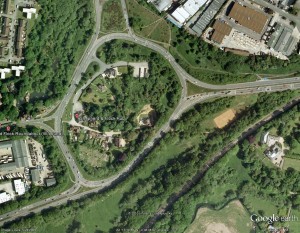Roundabouts or traffic circles as they are known in some parts of the world, are a common feature of modern life. They can range greatly in size; some are big enough to house small communities such as the Shepherd & Flock roundabout on the outskirts of Farnham, Surrey, which has it’s own pub,

whilst others are simple grass covered circles, such as the one shown below on the outskirts of Bracknell, Berkshire. Others, even if lacking pubs, may have a mixture of different plants present, some even with mature trees on them, such as the Sports Centre roundabout also in Bracknell.


Traditionally, roundabouts have been thought of as simple devices to regulate the flow of traffic and were usually circular raised areas of tarmac, stone, concrete or brick. More recently however, town and city councils began to add plants and/or artwork. Some of my favourites in this latter category are found in southern France as shown below or in the title picture of my blog site.


Ecologically speaking however, roundabouts are even more interesting. For almost fifteen years, I and a number of my students, from undergraduate to post-graduate, have been investigating the ecology of roundabouts and other green spaces in the town of Bracknell, Berkshire. What started as a purely pedagogic exercise (Leather & Helden, 2005a), turned into a voyage of discovery and a realisation that roundabouts are, and can be, great sources of biodiversity (Helden & Leather, 2004), and in addition, could perhaps act as nature reserves (Leather & Helden, 2005b). With close attention to mowing regimes (Helden & Leather, 2004) and increasing the proportion of native trees and other plants on them, it is not only insect diversity that is enhanced, but birds also (Helden et al., 2012).
We have found that roundabouts behave very similarly to biogeographical islands, i.e. the bigger they are and the more diverse the habitats present, the more diverse and interesting the fauna that can be found on them. For example, we found the rare and endangered bug (Hemiptera) Gonocerus acuteangulatus, alive and well on one of the roundabouts and amusingly, another species, Athysanus argentarius, usually found in coastal locations. Perhaps the salt from winter gritting operations fooled it.


Roundabouts may not be the equivalent of tropical forests but, they and other urban features such as suburban gardens, as demonstrated by Kevin Gaston and colleagues in a series of ground-breaking papers arising from the BUGS project http://www.bugs.group.shef.ac.uk/ in Sheffield and Jennifer Owen in her 30-year study of her Leicester garden (Owen, 2010), are immensely valuable tools for enhancing and conserving biodiversity in our increasingly impoverished world. We have much more to report, from bees, to butterflies and even woodlice. Watch this space for future instalments.
Helden, A. J. & Leather, S. R. (2004). Biodiversity on urban roundabouts – Hemiptera, management and the species-area relationship. Basic and Applied Ecology 5: 367-377. https://www.harper-adams.ac.uk/staff/profile/files/uploaded/Helden & Leather2004.pdf
Helden, A. J., Stamp, G. C. & Leather, S. R. (2012). Urban biodiversity: comparison of insect assemblages on native and non-native trees. Urban Ecosystems 15: 611-624. https://www.harper-adams.ac.uk/staff/profile/files/uploaded/Helden_et_al_2012.pdf
Leather, S. R. & Helden, A. J. (2005a). Magic roundabouts? Teaching conservation in schools and universities. Journal of Biological Education 39: 102-107. http://www.harper-adams.ac.uk/staff/profile/files/uploaded/Leather_&_Helden_JBE_2005.pdf
Leather, S. R. & Helden, A. J. (2005). Roundabouts: our neglected nature reserves? Biologist 52: 102-106. http://www.harper-adams.ac.uk/staff/profile/files/uploaded/Leather_&_Helden_Biologist_2005.pdf
Owen, J. (2010 ) Wildlife of a Garden: A Thirty Year Study, Royal Horticultural Society, London











